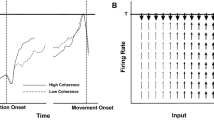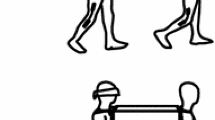Abstract
In this paper, I outline two strands of evidence for the conclusion that the dynamical approach to cognitive science both seeks and provides covering law explanations. Two of the most successful dynamical models—Kelso’s model of rhythmic finger movement and Thelen et al.’s model of infant perseverative reaching—can be seen to provide explanations which conform to the famous explanatory scheme first put forward by Hempel and Oppenheim. In addition, many prominent advocates of the dynamical approach also express the provision of this kind of explanation as a goal of dynamical cognitive science. I conclude by briefly outlining two consequences. First, dynamical cognitive science’s explanatory style may strengthen its links to the so-called “situated” approach to cognition, but, secondly, it may also undermine the widespread intuition that dynamics is related to emergentism in the philosophy of mind.


Similar content being viewed by others
Notes
Thompson (2007).
Tschacher and Haken (2007).
Kelso (2003, p. 46).
Kelso (1995, p. 49).
See Van Gelder (1999) for a good summary.
van Gelder (1998, p. 625). My emphasis.
Ibid.
Ibid.
Clark (1997, p. 119).
Bechtel (1998, p. 311).
Bechtel and Abrahamsen (2002, p. 267).
Putting it like this makes it clear why such explanations are sometimes called “deductive-nomological” explanations. Bill Seager has suggested that “covering law” explanation might be construed as a broader category than “deductive-nomological” if the former is intended to cover deduction from statistical and probabilistic laws whereas the latter is not. Since I am more interested in the deductive form of the explanation than the content of the laws, I shall use the former, broader, phrase.
Hempel and Oppenheim say that initial conditions aren’t necessary so that cases where one law is deduced from another count as explanations. So, suppose one asked a question such as “Why is Boyle’s law such that p = k(v/t)?” An answer would show how p = k(v/t) is derived from a law of statistical thermodynamics. Even though the answer does not mention any initial conditions, Hempel and Oppenheim still want this to count as an explanation (i.e., an answer to the explanation-seeking question).
Hempel (1965, p. 337). Italics in original. Note how this description assimilates explanation and prediction.
All four quotations are from Hempel and Oppenheim (1948, p. 137).
Ibid., p. 138.
I owe this point to Kukla (2001) who writes: “an experiment may be defined as an arrangement whereby the antecedent of a counterfactual is satisfied, whereupon we can observe whether the consequent falls into line.” (p. 48).
Thelen et al. (2001, p. 1).
Van Gelder (1991, p. 500).
Ibid.
Van Gelder and Port (1995, p. 14).
Ibid., p. 19.
Clark (1997, p. 100).
Ibid., p. 115.
Holland (1998, p. 45).
Carruthers (2004, p. 159).
We might want to say that the height of the flagpole explains the length of the shadow, but we would not normally want to say that the length of the shadow explains the height of the flagpole. The covering law model offers no way to distinguish between the two with the former being the genuine explanation.
Consider the following (covering law) explanation: All males who take birth control pills regularly do not get pregnant, John Jones takes birth control pills regularly, therefore John Jones does not get pregnant. Such an argument conforms to a covering law scheme, but we would not normally want to say that the premises are a good explanation of why John Jones fails to get pregnant.
Van Gelder (1991, p. 500).
Thanks to Christian Lacroix for pointing this out.
Kim (1999, p. 17).
Bird (1999, p. 17).
Glymour (2007).
See, for example, Chemero (2001).
References
Bechtel, W. (1998). Representations and cognitive explanations: assessing the dynamicist’s challenge in cognitive science. Cognitive Science, 22(3), 295–318.
Bechtel, W., & Abrahamsen, A. (2002). Connectionism and the mind (2nd ed.). Oxford: Blackwell.
Bedau, M. (1997). Emergent models of supple dynamics in life and mind. Brain and Cognition, 34, 5–27.
Beer, R. (1995). A dynamical systems perspective on agent-environment interaction. Artificial Intelligence, 72, 173–215.
Bird, A. (1999). Explanation and laws. Synthese, 120, 1–18.
Brooks, R. (1991). Intelligence without representation. Artificial Intelligence, 47, 139–159.
Busemeyer, J., & Townsend, J. T. (1993). Decision field theory: a dynamic-cognitive approach to decision making in an uncertain environment. Psychological Review, 100, 432–459
Carruthers, P. (2004). Reductive explanation and the explanatory gap. Canadian Journal of Philosophy, 34(2), 153–173.
Chemero, A. (2001). Dynamical explanation and mental representation. Trends in Cognitive Science, 5(4), 141–142.
Clark, A. (1997). Being there: Putting brain, body and world together again. Cambridge, MA: MIT Press.
Foss, J. (1992). Introduction to the epistemology of the brain: Indeterminacy, micro-specificity, chaos, and openness. Topoi, 11, 45–57.
Globus, G. (1992). Toward a noncomputational cognitive science. Journal of Cognitive Neuroscience, 4, 299–310.
Glymour, B. (2007). In defence of explanatory deductivism. In J. K. Campbell, M. O’Rourke & H. Silverstein (Eds.), Causation and explanation. Cambridge, MA: MIT Press.
Haken, H., Kelso, J. A. S., & Bunz, H. (1985). A theoretical model of phase transitions in human hand movements. Biological Cybernetics, 51, 347–356.
Hempel, C. G. (1965). “Aspects of Scientific Explanation” in his aspects of scientific explanation and other essays in the philosophy of science. New York: Free Press
Hempel, C. G., & Oppenheim, P. (1948). Studies in the logic of explanation. Philosophy of Science, 15, 135–175.
Holland, J. (1998). Emergence: From chaos to order. Reading, MA: Perseus.
Horgan, T., & Tienson, J. (1992). Cognitive systems as dynamic systems. Topoi, 11, 27–43.
Horgan, T., & Tienson, J. (1994). A nonclassical framework for cognitive science. Synthese, 101, 305–345.
Horgan, T., & Tienson, J. (1996). Connectionism and the philosophy of psychology. Cambridge, MA: MIT Press.
Jost, J. (2005). Dynamical systems. Berlin: Springer-Verlag.
Kelso, J. A. S. (1995). Dynamic patterns: The self-organisation of brain and behavior. Cambridge, MA: MIT Press.
Kelso, J. A. S. (2003). Cognitive coordination dynamics. In W. Tschacher & J.-P. Dauwalder (Eds.), The dynamical systems approach to cognition (pp. 45–67). Singapore: World Scientific.
Kim, J. (1999). Hempel, explanation, metaphysics. Philosophical Studies, 94, 1–20.
Kukla, A. (2001). Methods of theoretical psychology. Cambridge, MA: MIT Press.
Pope, A. (1903) In H. W. Boynton (Ed.). The complete poetical works of Alexander Pope. Boston: Houghton Mifflin.
Salmon, W. (1984). Scientific explanation and the causal structure of the world. Princeton: Princeton University Press.
Skarda, C. A., & Freeman, W. J. (1987). How brains make chaos in order to make sense of the world. Behavioral and Brain Sciences, 10, 161–195.
Thelen, E., Schöner, G., Scheier, C., & Smith, L. B. (2001). The dynamics of embodiment: A field theory of infant perseverative reaching. Behavioral and Brain Sciences, 24, 1–86.
Thelen, E., & Smith, L. B. (1994). A dynamic systems approach to the development of cognition and action. Cambridge, MA: MIT Press.
Thompson, E. (2007). Mind in life: Biology, phenomenology and the cognitive sciences. Harvard: Harvard University Press.
Tschacher, W., & Haken, H. (2007). Intentionality in non-equilibrium systems? The functional aspects of self-organized pattern formation. New Ideas in Psychology, 25, 1–15.
van Gelder, T. (1991). Connectionism and dynamical explanation. In Proceedings of the Thirteenth Annual Conference of the Cognitive Science Society. Hillsdale N.J.: L. Erlbaum Associates (pp. 499–503).
van Gelder, T. (1995). What might cognition be, if not computation? Journal of Philosophy, xci(7), 345–381.
van Gelder, T. (1997a). Connectionism, dynamics and the philosophy of mind. In M. Carrier & P. K. Machamer (Eds.), Mindscapes: Philosophy, science and the mind (pp. 245–269). Pittsburgh: University of Pittsburgh Press.
van Gelder, T. (1997b). Dynamics and cognition. In J. Haugeland (Ed.), Mind design II. Cabridge, MA: MIT Press.
van Gelder, T. (1998). The Dynamical Hypothesis in Cognitive Science. (with peer commentary). Behavioural and Brain Sciences, 21, 615–665.
van Gelder, T. (1999). Revisiting the dynamical hypothesis. Preprint No. 2/99, University of Melbourne, Department of Philosophy. Available at http://www.arts.unimelb.edu.au/~tgelder/papers/Brazil.pdf. Accessed 13 August 2004.
van Gelder, T., & Port, R. (1995). “It’s about time: An overview of the dynamical approach to cognition. In R. Port, T. Van Gelder (Eds.), Mind as motion. Cambridge, MA: MIT Press.
Author information
Authors and Affiliations
Corresponding author
Rights and permissions
About this article
Cite this article
Walmsley, J. Explanation in Dynamical Cognitive Science. Minds & Machines 18, 331–348 (2008). https://doi.org/10.1007/s11023-008-9103-9
Received:
Accepted:
Published:
Issue Date:
DOI: https://doi.org/10.1007/s11023-008-9103-9




